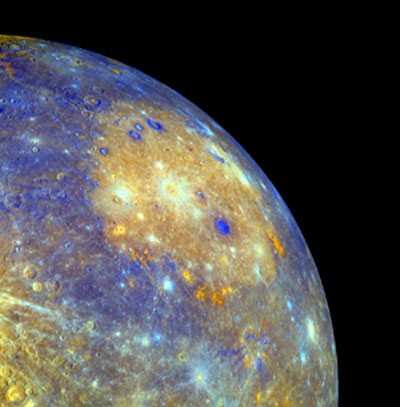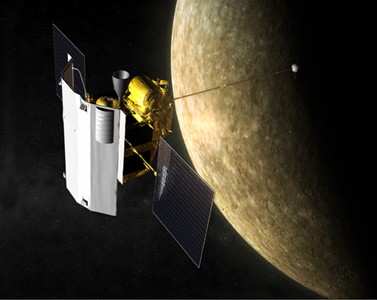New Research Shows Volcanoes, Magnetic Field Involved In
Formation
Scientists have argued about the origins of Mercury's smooth
plains and the source of its magnetic field for more than 30 years.
Now, analyses of data from the January 2008 flyby of the planet by
the Mercury Surface, Space Environment, Geochemistry and Ranging
(MESSENGER) spacecraft have shown that volcanoes were involved in
plains formation and suggest that its magnetic field is actively
produced in the planet's core.

Scientists also took their first look at the chemical
composition of the planet's surface, NASA tells Aero-News. The tiny
craft probed the composition of Mercury's thin atmosphere, sampled
charged particles (ions) near the planet, and demonstrated new
links between both sets of observations and materials on Mercury's
surface.
The results are reported in a series of 11 papers published in a
special section of Science magazine July 4.
The controversy over the origin of Mercury's smooth plains began
with the 1972 Apollo 16 moon mission, which suggested that some
lunar plains came from material that was ejected by large impacts
and then formed smooth "ponds." When Mariner 10 imaged similar
formations on Mercury in 1975, some scientists believed that the
same processes were at work. Others thought Mercury's plains
material came from erupted lavas, but the absence of volcanic vents
or other volcanic features in images from that mission prevented a
consensus.
Six of the papers in Science report on analyses of the planet's
surface through its reflectance and color variation, surface
chemistry, high-resolution imaging at different wavelengths, and
altitude measurements. The researchers found evidence of volcanic
vents along the margins of the Caloris basin, one of the solar
system's youngest impact basins. They also found that Caloris has a
much more complicated geologic history than previously
believed.
The first altitude measurements from any spacecraft at Mercury
also found that craters on the planet are about a factor of two
shallower than those on Earth's moon. The measurements also show a
complex geologic history for Mercury.
Mercury's core makes up at least 60 percent of its mass, a
figure twice as large as any other known terrestrial planet. The
flyby revealed that the magnetic field, originating in the outer
core and powered by core cooling, drives very dynamic and complex
interactions among the planet's interior, surface, exosphere and
magnetosphere.
Remarking on the importance of the core to surface geological
structures, Principal Investigator Sean Solomon at the Carnegie
Institution of Washington said, "The dominant tectonic landforms on
Mercury, including areas imaged for the first time by MESSENGER,
are features called lobate scarps, huge cliffs that mark the tops
of crustal faults that formed during the contraction of the
surrounding area. They tell us how important the cooling core has
been to the evolution of the surface. After the end of the period
of heavy bombardment, cooling of the planet's core not only fueled
the magnetic dynamo, it also led to contraction of the entire
planet. And the data from the flyby indicate that the total
contraction is a least one-third greater than we previously
thought."

The flyby also made the first-ever observations of the ionized
particles in Mercury's unique exosphere. The exosphere is an
ultrathin atmosphere in which the molecules are so far apart they
are more likely to collide with the surface than with each other.
The planet's highly elliptical orbit, its slow rotation and
particle interactions with the magnetosphere, interplanetary medium
and solar wind result in strong seasonal and day-night differences
in the way particles behave.
 Bolen Gives Congress a Rare Thumbs-Up
Bolen Gives Congress a Rare Thumbs-Up The SportPlane Resource Guide RETURNS!!!!
The SportPlane Resource Guide RETURNS!!!! Buying Sprees Continue: Textron eAviation Takes On Amazilia Aerospace
Buying Sprees Continue: Textron eAviation Takes On Amazilia Aerospace Hawker 4000 Bizjets Gain Nav System, Data Link STC
Hawker 4000 Bizjets Gain Nav System, Data Link STC Echodyne Gets BVLOS Waiver for AiRanger Aircraft
Echodyne Gets BVLOS Waiver for AiRanger Aircraft




